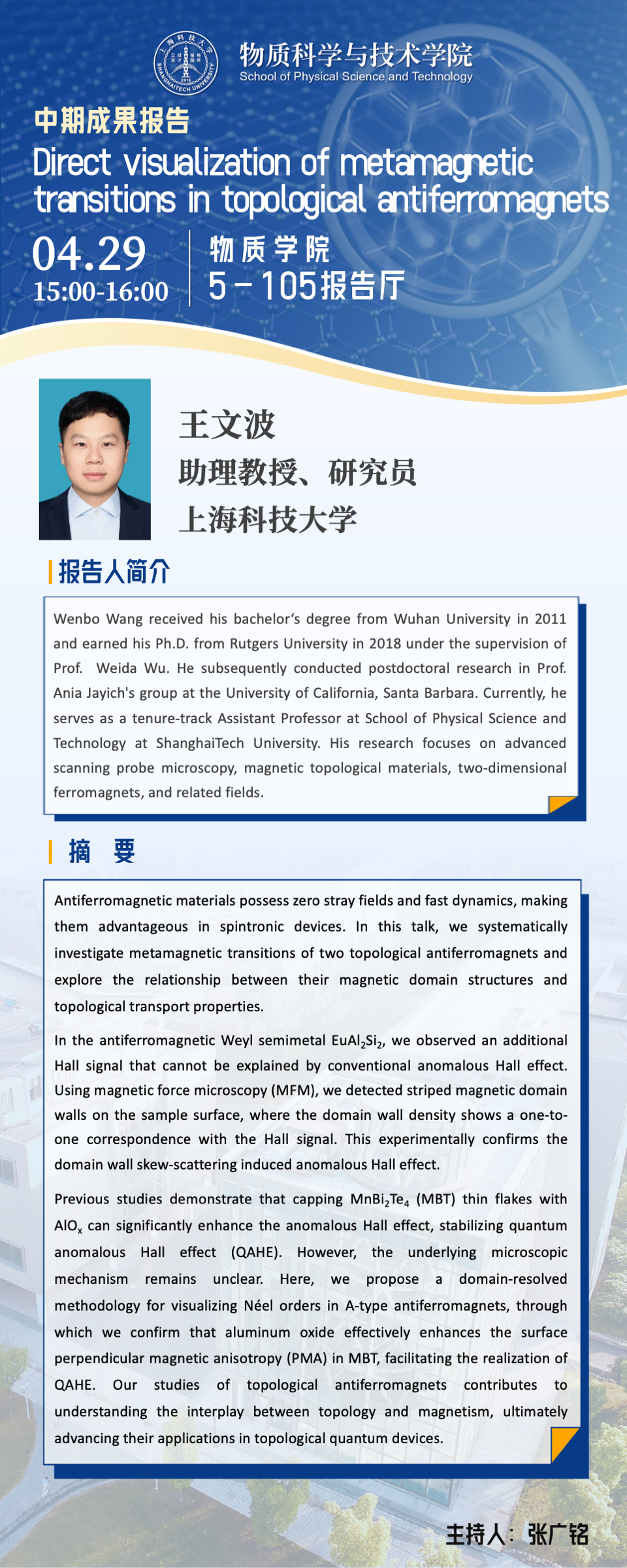X
+
-
重置

题目(Title):
Direct visualization of metamagnetic transitions in topological antiferromagnets
主讲人(Speaker):
王文波
开始时间(Start Time):
2025-04-29 15:00
结束时间(End Time):
2025-04-29 16:00
报告地点(Place):
物质学院5-105报告厅
主办单位(Organization):
物质科学与技术学院
协办单位(Co-organizer):
简介(Brief Introduction):
报告人简介:
Wenbo Wang received his bachelor‘s degree from Wuhan University in 2011 and earned his Ph.D. from Rutgers University in 2018 under the supervision of Prof. Weida Wu. He subsequently conducted postdoctoral research in Prof. Ania Jayich's group at the University of California, Santa Barbara. Currently, he serves as a tenure-track Assistant Professor at School of Physical Science and Technology at ShanghaiTech University. His research focuses on advanced scanning probe microscopy, magnetic topological materials, two-dimensional ferromagnets, and related fields.
讲座摘要:
Antiferromagnetic materials possess zero stray fields and fast dynamics, making them advantageous in spintronic devices. In this talk, we systematically investigate metamagnetic transitions of two topological antiferromagnets and explore the relationship between their magnetic domain structures and topological transport properties.
In the antiferromagnetic Weyl semimetal EuAl2Si2, we observed an additional Hall signal that cannot be explained by conventional anomalous Hall effect. Using magnetic force microscopy (MFM), we detected striped magnetic domain walls on the sample surface, where the domain wall density shows a one-to-one correspondence with the Hall signal. This experimentally confirms the domain wall skew-scattering induced anomalous Hall effect.
Previous studies demonstrate that capping MnBi2Te4 (MBT) thin flakes with AlOx can significantly enhance the anomalous Hall effect, stabilizing quantum anomalous Hall effect (QAHE). However, the underlying microscopic mechanism remains unclear. Here, we propose a domain-resolved methodology for visualizing Néel orders in A-type antiferromagnets, through which we confirm that aluminum oxide effectively enhances the surface perpendicular magnetic anisotropy (PMA) in MBT, facilitating the realization of QAHE. Our studies of topological antiferromagnets contributes to understanding the interplay between topology and magnetism, ultimately advancing their applications in topological quantum devices.
邀请人:张广铭
Wenbo Wang received his bachelor‘s degree from Wuhan University in 2011 and earned his Ph.D. from Rutgers University in 2018 under the supervision of Prof. Weida Wu. He subsequently conducted postdoctoral research in Prof. Ania Jayich's group at the University of California, Santa Barbara. Currently, he serves as a tenure-track Assistant Professor at School of Physical Science and Technology at ShanghaiTech University. His research focuses on advanced scanning probe microscopy, magnetic topological materials, two-dimensional ferromagnets, and related fields.
讲座摘要:
Antiferromagnetic materials possess zero stray fields and fast dynamics, making them advantageous in spintronic devices. In this talk, we systematically investigate metamagnetic transitions of two topological antiferromagnets and explore the relationship between their magnetic domain structures and topological transport properties.
In the antiferromagnetic Weyl semimetal EuAl2Si2, we observed an additional Hall signal that cannot be explained by conventional anomalous Hall effect. Using magnetic force microscopy (MFM), we detected striped magnetic domain walls on the sample surface, where the domain wall density shows a one-to-one correspondence with the Hall signal. This experimentally confirms the domain wall skew-scattering induced anomalous Hall effect.
Previous studies demonstrate that capping MnBi2Te4 (MBT) thin flakes with AlOx can significantly enhance the anomalous Hall effect, stabilizing quantum anomalous Hall effect (QAHE). However, the underlying microscopic mechanism remains unclear. Here, we propose a domain-resolved methodology for visualizing Néel orders in A-type antiferromagnets, through which we confirm that aluminum oxide effectively enhances the surface perpendicular magnetic anisotropy (PMA) in MBT, facilitating the realization of QAHE. Our studies of topological antiferromagnets contributes to understanding the interplay between topology and magnetism, ultimately advancing their applications in topological quantum devices.
邀请人:张广铭



 沪公网安备 31011502006855号
沪公网安备 31011502006855号